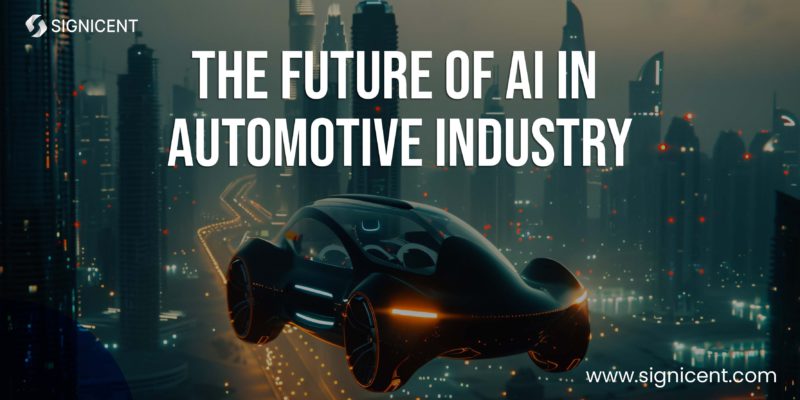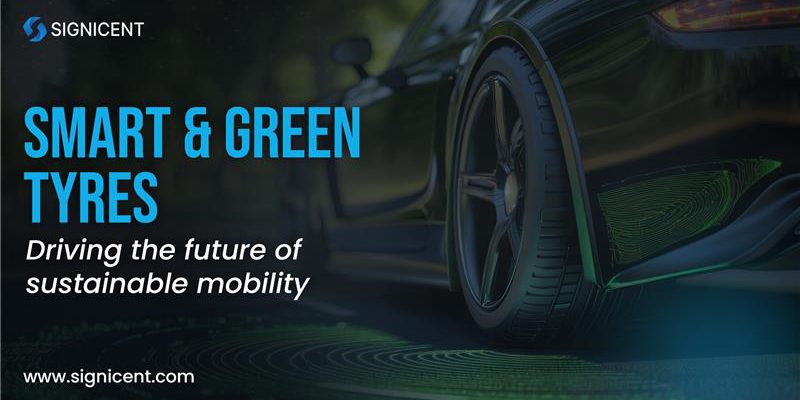In this new age, AI in the automotive industry is reshaping how vehicles are built, maintained, and operated. From predictive maintenance to autonomous driving, AI is addressing critical global challenges such as vehicle safety, sustainability, and efficiency. With many automotive companies facing shutdowns due to outdated business models and rising operational costs, AI-driven solutions are enabling a competitive edge.
Lidar mapping and various IoT systems inside automotive vehicles are accelerating the shift from driver-assisted to fully driverless technology. These advancements enable precise parts-to-parts identification, ensuring seamless vehicle operation and enhanced safety.
Countries with strong automotive sectors, like Germany, the U.S., and Japan, are witnessing a shift toward AI-powered innovations to improve production efficiency and reduce waste. AI ensures accuracy and precision in manufacturing, minimizes human error, and enhances vehicle longevity.
This report explores key AI-driven innovations in automotive, highlighting leading key layers and startups founded after 2020 that are tackling global challenges. We focus on AI-powered autonomous driving, predictive maintenance, AI-driven manufacturing, digital twins, and smart tire technology, showcasing how new-age companies are leading the transformation.
Signicent’s Patent Landscape Analysis identifies AI-powered automotive patents, helping businesses assess competitive positioning, innovation gaps, and regulatory trends in intelligent transportation.
Challenges in the Automotive Sector
- Manufacturing Inefficiencies & High Costs – Car manufacturers struggle with expensive prototyping, leading to delays, material wastage, and costly recalls due to design flaws detected late in the process.
- Unexpected Mechanical Failures & Safety Risks – Drivers face sudden brake failures, engine breakdowns, and tire bursts, often with no prior warning, resulting in accidents, repair expenses, and road delays.
- Ineffective Maintenance Strategies – Traditional maintenance relies on fixed schedules rather than real-time data, causing either premature part replacements or costly breakdowns due to delayed servicing.
- Traffic Congestion & Human Error Accidents – Urban areas suffer from gridlocks, long commute times, and increasing accident rates due to reckless driving, fatigue, and poor real-time traffic decision-making.
- Energy Inefficiency in Electric Vehicles (EVs) – Limited battery optimization reduces driving range, increases charging duration, causes thermal inefficiencies, and affects overall vehicle performance under varying environmental conditions.
These long-standing challenges impact consumer experience, safety, and industry efficiency, demanding AI-driven solutions to reshape the future of mobility.
Signicent’s Technology Gap Analysis detects missing AI-driven automotive capabilities, enabling companies to bridge innovation gaps and enhance competitiveness.
What’s New in the Automotive Sector?
The automotive industry is experiencing a rapid transformation fueled by AI-driven advancements. Key developments include:
- Next-Gen AI Chips for Autonomous Vehicles: Companies like Nvidia and Qualcomm are developing ultra-fast AI processors that enhance real-time decision-making in self-driving cars.
- AI-Enabled Road Infrastructure: Smart traffic lights, AI-powered pedestrian detection, and automated tolling systems are improving urban mobility and reducing congestion.
- Hyper-Personalized In-Car Experiences: AI-integrated infotainment systems, voice assistants, and adaptive climate control enhance driver comfort and convenience.
- Self-Healing Materials: AI-assisted materials research is enabling self-repairing car paints and tires, reducing maintenance needs.
- Vehicle-to-Everything (V2X) Communication: AI-powered connectivity solutions enable vehicles to interact with surrounding infrastructure, reducing accidents and optimizing traffic flow.
Signicent’s Technology Landscape Analysis reveals AI trends in autonomous driving, helping automotive firms align R&D investments with future industry shifts.
| Technology/Service | Challenge | Solution | Company |
| Digital Twins | High R&D costs, inefficient testing | Virtual prototyping, predictive analysis | Ford |
| IoT Sensors | Wear and tear, lack of real-time data | Real-time monitoring, predictive maintenance | Michelin |
| AI-Powered ADAS | Human error, traffic congestion | Collision detection, lane assistance | Tesla |
| AI-Driven Supply Chain | Supply chain disruptions, inefficiency | Demand forecasting, inventory optimization | BMW |

AI Innovations Transforming the Automotive Sector
AI is reshaping the automotive sector by improving manufacturing, preventing breakdowns, optimizing repairs, managing traffic, and enhancing electric vehicle performance. Below are key AI-driven innovations and the companies leading their development.
1. AI-Powered Digital Twins – Optimizing Automotive Manufacturing
Companies like Siemens and General Motors use AI-driven digital twins to improve production efficiency and minimize design flaws.
- Virtual Prototyping & Testing – AI simulates vehicle prototypes in a digital twin environment, detecting structural weaknesses before production.
- AI-Powered Factory Automation – Machine learning algorithms optimize assembly lines by predicting system failures, reducing downtime, and improving production speed.
- Predictive Quality Control – Computer vision monitors real-time production data to identify defects early, reducing material waste and recalls.
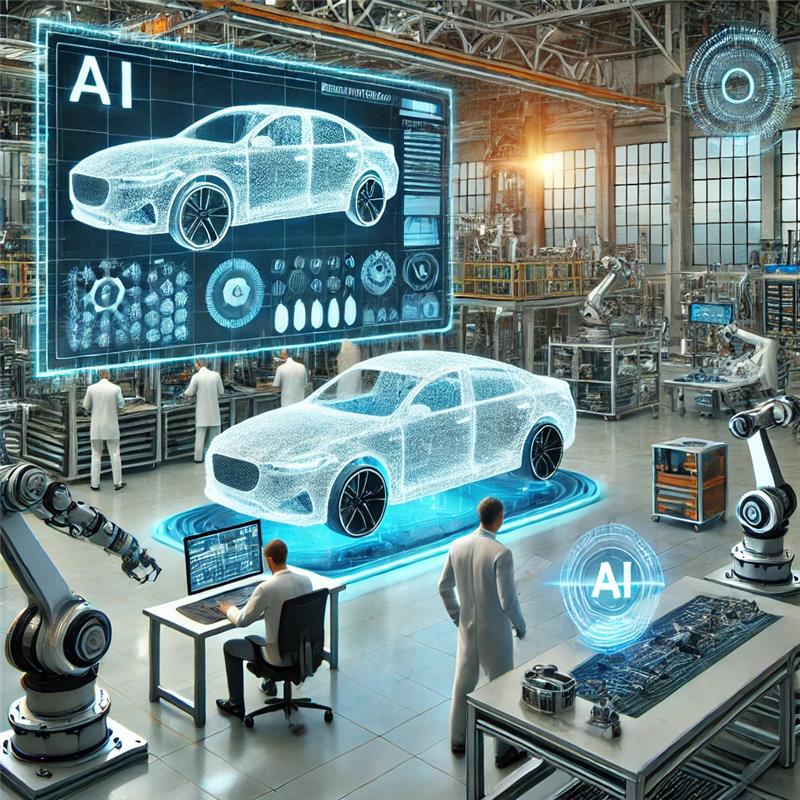
2. AI-Driven Predictive Maintenance – Preventing Sudden Mechanical Failures
Companies like Bosch and Continental integrate AI into predictive maintenance systems to enhance vehicle health monitoring.
- AI-Integrated Sensors – Edge computing sensors track tire pressure, engine performance, and braking systems to detect issues before they lead to failure.
- Cloud-Based Diagnostics – AI-powered telematics analyze connected vehicle data to predict part failures and recommend preventive maintenance.
- Automated Service Alerts – Machine learning models assess vehicle usage and send alerts for necessary maintenance, preventing unnecessary part replacements.
3. AI-Based Smart Maintenance – Improving Repair Efficiency
Companies like ZF Friedrichshafen and Bridgestone apply AI to improve repair accuracy and reduce vehicle downtime.
- AI-Powered Wear Detection – Computer vision examines images from vehicle cameras and repair shop diagnostics to detect component wear levels.
- Connected Vehicle Ecosystems – IoT-based diagnostics integrate performance data with repair centers, streamlining spare parts inventory and minimizing service delays.
- Self-Learning Repair Models – Deep learning algorithms update vehicle maintenance data continuously, improving troubleshooting accuracy.
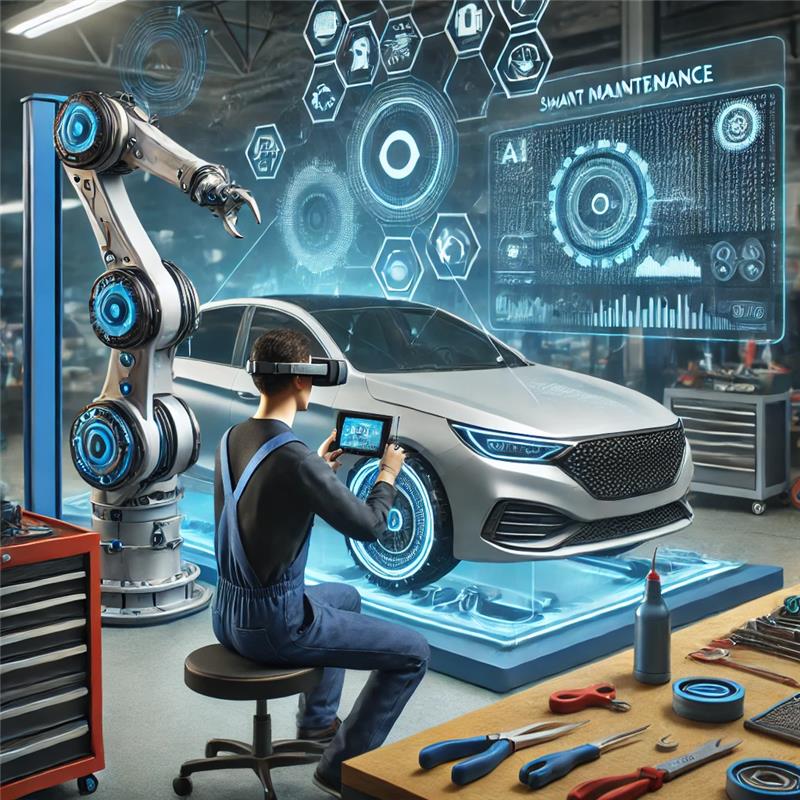
4. AI-Enhanced Traffic Management & Autonomous Driving
Companies like Waymo and Mobileye develop AI-powered solutions for real-time traffic optimization and autonomous vehicle safety.
- Real-Time Traffic Optimization – AI-driven traffic flow analysis predicts congestion patterns and optimizes traffic light timing to improve movement efficiency.
- Autonomous Driving with AI Vision – LIDAR sensor mapping processes real-time data to detect pedestrians, road signs, and obstacles for safer navigation.
- Vehicle-to-Everything (V2X) Communication – 5G-enabled AI systems allow vehicles to exchange data with other cars, traffic signals, and road infrastructure to prevent accidents.
5. AI-Optimized EV Battery & Energy Efficiency
Companies like CATL and NIO use AI to enhance electric vehicle battery performance, energy management, and charging efficiency.
- AI-Powered Battery Thermal Management – Neural networks regulate battery temperature, preventing overheating and maximizing energy storage capacity.
- Intelligent Energy Consumption Analysis – AI evaluates driving patterns to optimize power distribution, increasing range and reducing energy waste.
- Smart Charging Algorithms – AI-driven grid analytics predict charging demand and adjust power distribution to minimize charging time and prevent shortages.
Signicent’s Design Patent Search ensures AI-integrated automotive designs maintain uniqueness, preventing infringement in smart vehicle aesthetics and aerodynamics.
Market Impact: Future Sales & Industry Growth
- According to Signicent’s market research, the global AI in the automotive market is expected to reach the projected value ranges, driven by advancements in AI-driven automation, autonomous driving, and connected vehicle ecosystems.
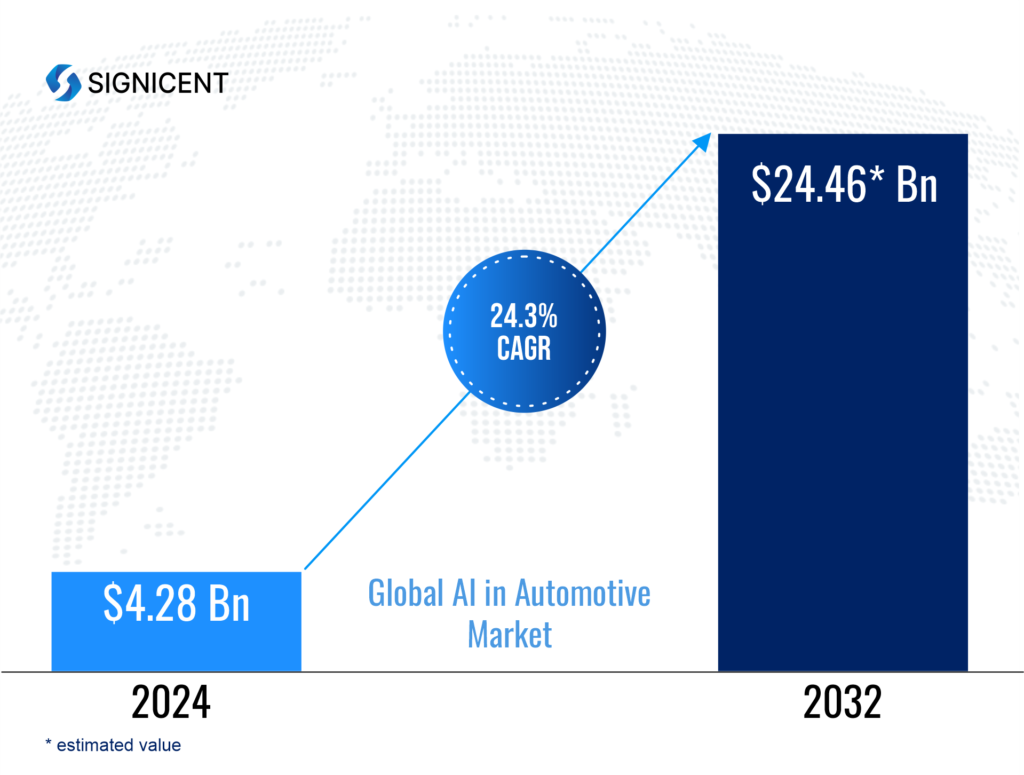
- Electric vehicles (EVs) are expected to dominate the industry, with AI playing a critical role in optimizing battery performance, self-driving capabilities, and predictive maintenance.
- AI-powered traffic management systems are projected to generate massive annual savings for cities by reducing congestion and enhancing fuel efficiency.
- The self-driving car sector is expected to see significant growth, with major players investing heavily in AI-driven safety protocols to advance autonomous mobility.
Signicent’s Market Intelligence delivers AI automotive insights, tracking trends, consumer preferences, and investment patterns shaping the industry’s future.
| Category | Leading Companies | Startups |
| R&D | Tesla, Toyota, BMW | Rivian, Canoo |
| Manufacturing & Production | Tesla, Volkswagen, Ford | Arrival, Fisker Inc. |
| Powertrain & Propulsion | Toyota, Tesla, GM | Lucid Motors, Nikola |
| Electronics & Smart Systems | Tesla, Bosch, Audi | Waymo, Aurora |

Real-Time Benefits of AI in Sustainable Mobility
AI technologies are transforming sustainability in the automotive sector, driving eco-friendly innovations and reducing environmental impact.
- Eco-Friendly Safety: Autonomous driving minimizes accident risks, leading to fewer vehicle repairs and reduced resource consumption. AI-powered predictive maintenance enhances vehicle longevity, reducing waste.
- Energy Efficiency: AI optimizes fuel consumption in traditional vehicles and enhances battery efficiency in EVs, reducing overall energy demand and emissions.
- Smart Mobility Solutions: AI-driven navigation and traffic management systems cut congestion and fuel wastage, leading to lower carbon footprints and improved air quality.
- Greener Future: AI accelerates sustainable automotive advancements, promoting cleaner transportation and supporting global efforts to reduce environmental impact.
Signicent’s Chemical Structure Search supports AI-driven automotive material research, optimizing nanocoatings, lubricants, and battery chemistries for enhanced vehicle performance and sustainability.
Signicent drives AI innovation in automotive by providing technology scouting, patent research, and innovation consulting. It enabled AI-powered predictive maintenance for real-time engine and brake monitoring, reducing breakdown risks. For autonomous driving R&D, Signicent’s patent landscape analysis helped startups identify key innovation areas. In EV technology, it delivered insights on AI-based battery thermal management for energy optimization. The company also analyzed green tire innovations, supporting sustainable manufacturing. Additionally, Signicent assisted smart city projects in deploying AI-driven traffic optimization, reducing congestion and fuel consumption.
Each year Signicent provides consultancy to hundreds of organizations to help transform their innovations to value.
Future Outlook for AI in Automotive
The future of AI in automotive is set to bring revolutionary advancements across various domains. Widespread autonomous driving will soon dominate urban transport, reducing reliance on human drivers and minimizing accident risks. The AI-driven EV revolution will significantly enhance battery performance and charging efficiency, extending driving range and reducing energy waste. Smart and sustainable manufacturing will leverage AI-powered automation, streamlining production lines, minimizing material waste, and improving eco-friendly manufacturing. The rise of advanced AI-powered navigation will enable vehicles to become highly connected, ensuring safer, faster, and more efficient commutes. Additionally, hyper-personalized vehicles will emerge, integrating AI to adapt to user preferences, creating a seamless and interactive driving experience tailored to individual needs. As the automotive industry continues to evolve, AI-driven innovations will redefine mobility, ensuring a future that is safer, smarter, and more sustainable.
About Signicent LLP
We assist businesses globally in their technology innovations, R&D, new product development, patents, valuation, product commercialization & market research needs.
Services Offered:
- Patent Landscape
- Patent Portfolio Analysis
- Patent Invalidity Search
- Patent Licensing Services
- Freedom to operate (FTO)
- Chemical Structure Search
- Design Patent Search
- Technology Scouting
- Technology Landscape Analysis
- Technology gap analysis
- Technology Intelligence
- Market Research
- Bio Sequence Search
- Manufacturers Search/ Supplier search
Elevate your Innovation and Research with Signicent’s cutting edge approach to assist you with Technology and Market related matters alongside the IP aspect of the analysis.
